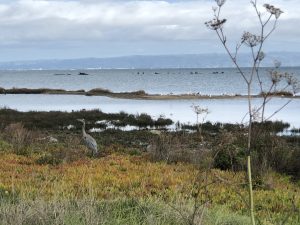 The goal of this collaboratively developed survey was to assess how much sea level rise (SLR) adaptation planning has occurred in the region, the challenges that local jurisdictions are facing, and how the region can support ongoing, coordinated, and interconnected planning that leads to real, on-the-ground planning. We heard from 42% of the 65 Bay shoreline jurisdictions invited to participate including 9 counties, 54 cities and 2 special districts. The results show a snapshot of sea level rise adaptation planning progress around the Bay, with special focus on barriers to effective sea level rise planning and adaptation at local jurisdictions.
The goal of this collaboratively developed survey was to assess how much sea level rise (SLR) adaptation planning has occurred in the region, the challenges that local jurisdictions are facing, and how the region can support ongoing, coordinated, and interconnected planning that leads to real, on-the-ground planning. We heard from 42% of the 65 Bay shoreline jurisdictions invited to participate including 9 counties, 54 cities and 2 special districts. The results show a snapshot of sea level rise adaptation planning progress around the Bay, with special focus on barriers to effective sea level rise planning and adaptation at local jurisdictions.
Key outcomes of the Sea Level Rise Adaptation Progress, Gaps & Needs report include:
- The good news is that most (81% of respondents) have some degree of information about their city’s vulnerability to SLR and nearly three-quarters (73%) have spent time or money in the past few years on adaptation projects, such shoreline protection or system upgrades. But there’s a disconnect – even though most know what is vulnerable and many are even working on projects, not everyone is thinking about long-term adaptation plans, including how to systematically respond to vulnerabilities or ensure that projects are working together (45% of respondents don’t have or aren’t working on an adaptation plan).
- So, what is holding people back? Almost everyone needs more money to do this (92% of respondents cited insufficient funds as a barrier), but most people are also challenged by lack of mandates (61%) and uncertainty about SLR timing (54%). Cities also cited the need for more technical support and technical tools as well as better relationships with state and planning or regulatory agencies as well as their own landowners, CBOs, and EJ communities. Many also recognize the need to collaborate with their neighbors – that they cannot do this alone and that impacts and solutions cross jurisdictional boundaries. 78% want better relationships with their neighboring towns and cities and 52% want better relationships with neighboring counties.
- How do these results support what’s next for the region? Bay Adapt proposes tasks that help overcome these barriers including more, and more targeted funding, improved communication of sea level rise science, assessing state mandates, and providing assistance with engagement, planning, and projects. The survey results also underscore the need to work together within communities, counties, the region, and the state – the premise upon which Bay Adapt was created.
Project Status
This report began in early 2021 and was completed in fall 2021. The results can be found below.
Findings and Materials
Related Projects
Project Partners
Special thanks to former Sea Grant Fellow Karen Tanner for leading this effort. Project partners included BCDC, BayCAN, MTC/ABAG, BARC, SFEI, and SFEP, who collaboration on survey development. Most importantly, this project would not have been possible without the survey participants from county, city, and special jurisdictions in the Bay Area.

For more information:
- Viktoria Kuehn
- Viktoria.kuehn@bcdc.ca.gov